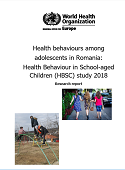Health behaviours among adolescents in Romania: Health Behaviour in School-aged Children (HBSC) study 2018: Research report (2020)

Download
The 2018/2019 cohort marks its 15 years of her Health Behaviour in School-aged Children (HBSC) study in Romania. It is one of the most ambitious initiatives aimed at understanding the developmental trajectories of health and well-being indicators in 11-, 13- and 15-year-old, tracking the evolution of these indicators with each four-year data-collection cycle. The 2018 data bring both bad and good news regarding the health and well-being of adolescents. First, social support remains relatively stable compared to previous years, except for perceived peer support, which diminishes, and perceived school pressure, which increases. Generally, perceived support from parents, peers and teachers decrease with age. Worrisome is the facts that, with age, life satisfaction and well-being get worse, for both genders: less than half of 15-year-old adolescents are generally satisfied with their lives. Simultaneously, there are continuous increases in emotional problems from 11 to 15, especially in girls. Half of the adolescents of all ages meet the recommendations of dental hygiene (twice a day). Physical activity levels are lower than they were in 2014, while sedentary behaviours are on a steady rise. On the positive side, overweight and obesity rates remain constant from 2014, with only a slight increase in girls but a decrease in boys. Bullying and violence are on a decreasing slope and, for the first time, insight is provided into the potential spread of cyberbullying. Similarly, fewer adolescents (compared to 2014) start their sexual life, but condom use is on a descending path for boys while on the rise for girls. Social inequalities continue to have considerable influence in some of the health and well-being indicators, especially for perceived social support, life satisfaction and some health behaviours, all generally favouring more economically affluent adolescents. For risk behaviours, the evidence is mixed: there is higher engagement with substance and alcohol use in adolescents with higher social status, but at the same time, the more affluent are more likely to engage in protective behaviours (such as using condoms during intercourse). The HBSC international study gives voice to the younger generation and brings their perceptions, views and worries regarding their health and well-being to centre stage. The wish is that their voices find echoes in the public health agenda of experts and politicians.



